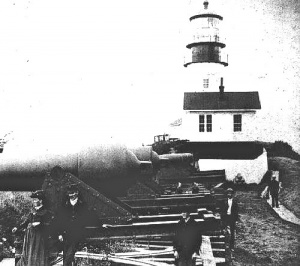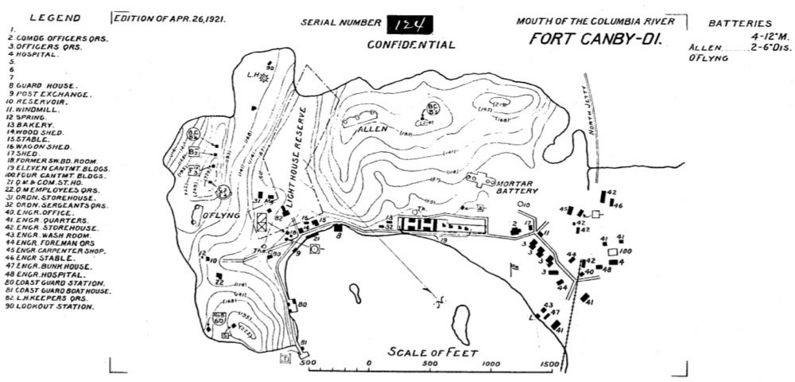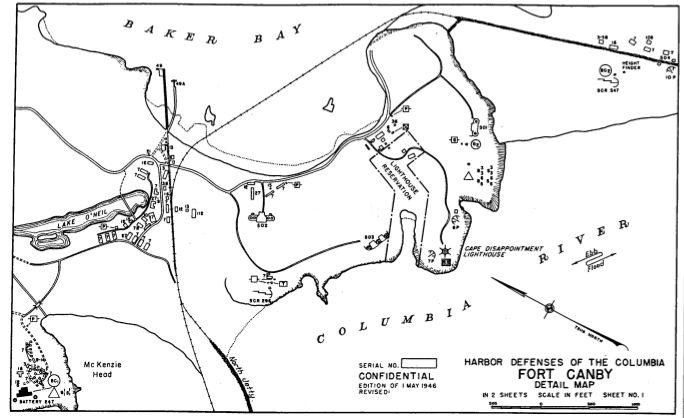Fort Canby: Difference between revisions
Nightshade (talk | contribs) No edit summary |
John Stanton (talk | contribs) No edit summary |
||
| Line 5: | Line 5: | ||
[[Image:FtCanbyAerial1937.gif|400px|thumb|right|1937 Aerial Shot]] | [[Image:FtCanbyAerial1937.gif|400px|thumb|right|1937 Aerial Shot]] | ||
{{Clr}} | {{Clr}} | ||
== | == [[U.S. Civil War]] (1861-1865) == | ||
In 1852 the War Department created a military reservation at Cape Disappointment to protect the mouth of the Columbia, but construction did not begin until August 1863. The post was completed and occupied by troops 15 Apr 1864. Several frame garrison buildings were erected and a fortification consisting of three earthwork batteries armed with smoothbore cannons was built to protect the mouth of the Columbia River. Engineer [[George H. Elliot]] was charged with building the three batteries which were known as "Lighthouse Battery", "Left Battery" and "Center Battery". | In 1852 the War Department created a military reservation at Cape Disappointment to protect the mouth of the Columbia, but construction did not begin until August 1863. The post was completed and occupied by troops 15 Apr 1864. Several frame garrison buildings were erected and a fortification consisting of three earthwork batteries armed with smoothbore cannons was built to protect the mouth of the Columbia River. Engineer [[George H. Elliot]] was charged with building the three batteries which were known as "Lighthouse Battery", "Left Battery" and "Center Battery". | ||
| Line 13: | Line 13: | ||
{{Clr}} | {{Clr}} | ||
The fort is said to be the site where, on 15 Nov 1805, members of the Lewis and Clark Corps of Discovery first stepped into the breaking surf of the Pacific Ocean. | The fort is said to be the site where, on 15 Nov 1805, members of the Lewis and Clark Corps of Discovery first stepped into the breaking surf of the Pacific Ocean. | ||
== | == [[Endicott Period]] (1890-1910) == | ||
{{HDColumbia}} Two other forts, [[Fort Stevens]] on the Oregon side and [[Fort Columbia]] on the Washington side of the Columbia River completed the Harbor Defense System. | |||
Between 1896 and 1908, after a long period of neglect during which the fort and its armament had become obsolete, the Army completely renovated them. New barracks and other buildings were constructed, and two batteries ([[Battery Harvey Allen]] and [[Battery O'Flyng]]) with a total of five rifled guns in concrete emplacements were installed. | |||
{{Clr}} | {{Clr}} | ||
{{FtCanbyEndicott}} | {{FtCanbyEndicott}} | ||
{{Clr}} | {{Clr}} | ||
== [[World War I]] (1917-1918) == | |||
In 1921 a new mortar battery, [[Battery Guenther]], with four 12" mortars was added with the mortars coming from [[Battery Clark]] on [[Fort Stevens]]. | |||
{{Clr}} | {{Clr}} | ||
[[Image:FortCanby 1921 Map.jpg|thumb|left|795px|Fort Canby Map 1921]] | [[Image:FortCanby 1921 Map.jpg|thumb|left|795px|Fort Canby Map 1921]] | ||
{{Clr}} | {{Clr}} | ||
==[[World War II]]== | == [[World War II]] (1941-1945) == | ||
The fort remained in caretaker status from the end of [[World War I]] to 21 Feb 1941 manned only by a sergeant and two enlisted men. The fort was reactivated in 1941 and in 1944 Battery 247 was added on McKenzie Head. In 1947 the fort was deactivated. Present surviving structures date from the World War II period. | |||
{{Clr}} | {{Clr}} | ||
{{FtCanbyWorldWarII}} | {{FtCanbyWorldWarII}} | ||
[[Image:Fort Canby 1946 Map.jpg|thumb|left|795px|Fort Canby Map 1946]] | [[Image:Fort Canby 1946 Map.jpg|thumb|left|795px|Fort Canby Map 1946]] | ||
{{Clr}} | {{Clr}} | ||
==Current Status== | ==Current Status== | ||
No period guns or carriages in place. | No period guns or carriages in place. | ||
---- | ---- | ||
{| | {| | ||
| Line 60: | Line 55: | ||
* Elevation: | * Elevation: | ||
|} | |} | ||
'''Recent Blog Posts:''' | |||
* [http://usforting.com/2009/08/01/battery-guenther-at-fort-canby/ Battery Guenther at Fort Canby] | |||
* [http://usforting.com/2008/09/17/battery-247-at-fort-canby/ Fort Canby Battery 247] | |||
* [http://usforting.com/2009/06/29/battery-oflyng-at-fort-canby/ Battery O'Flyng at Fort Canby] | |||
'''Sources:''' | '''Sources:''' | ||
| Line 65: | Line 64: | ||
* {{Frazer}}, page 171 | * {{Frazer}}, page 171 | ||
* {{Roberts}}, page 829-830 | * {{Roberts}}, page 829-830 | ||
* {{HanftCape}} | * {{HanftCape}} | ||
{{HBSuppColumbiaWWII}} | |||
'''Links:''' | '''Links:''' | ||
* | * [http://www.northamericanforts.com/West/wa2.html#columbia North American Forts - Fort Canby] | ||
* [http://www.parks.wa.gov/parkpage.asp?selectedpark=Cape+Disappointment&pageno=1 Cape Disappointment] | * [http://www.parks.wa.gov/parkpage.asp?selectedpark=Cape+Disappointment&pageno=1 Cape Disappointment] | ||
* [http://www.cr.nps.gov/history/online_books/lewisandclark/site39.htm National Parks History] | * [http://www.cr.nps.gov/history/online_books/lewisandclark/site39.htm National Parks History] | ||
* {{CDSGMainLink}} | |||
{{Visited|16 Feb 2008, Sep 2005}} | {{Visited|16 Feb 2008, Sep 2005}} | ||
| Line 89: | Line 89: | ||
[[Category:Washington All]] | [[Category:Washington All]] | ||
[[Category:Washington Forts]] | [[Category:Washington Forts]] | ||
[[Category:Washington Pacific County]] | |||
[[Category:Preserved]] | [[Category:Preserved]] | ||
[[Category:State Park]] | [[Category:State Park]] | ||
[[Category:Coastal Forts]] | [[Category:Coastal Forts]] | ||
[[Category:Endicott Period Forts]] | [[Category:Endicott Period Forts]] | ||
[[Category:World War II Forts]] | |||
[[Category:Harbor Defense of the Columbia]] | [[Category:Harbor Defense of the Columbia]] | ||
[[Category:Columbia River Forts]] | [[Category:Columbia River Forts]] | ||
[[Category:{{PAGENAME}}]] | [[Category:{{PAGENAME}}]] | ||
Revision as of 15:35, 5 June 2011
Fort Canby (1852-1947) - Established in 1863 during the U.S. Civil War and activated 15 Apr 1864. First named Fort Cape Disappointment and renamed Fort Canby 13 Feb 1875 by War Department General Order No. 5 after General Edward R.S. Canby, who was killed in the Modoc Indian War. Deactivated 28 Mar 1947.


U.S. Civil War (1861-1865)
In 1852 the War Department created a military reservation at Cape Disappointment to protect the mouth of the Columbia, but construction did not begin until August 1863. The post was completed and occupied by troops 15 Apr 1864. Several frame garrison buildings were erected and a fortification consisting of three earthwork batteries armed with smoothbore cannons was built to protect the mouth of the Columbia River. Engineer George H. Elliot was charged with building the three batteries which were known as "Lighthouse Battery", "Left Battery" and "Center Battery".
The Lighthouse Battery had a total of seven guns, two 8", four 10" and one huge 15" Rodman smoothbore mounted on a center pintle in front of the lighthouse. All three batteries were to meant house a total of 22 guns.

The fort is said to be the site where, on 15 Nov 1805, members of the Lewis and Clark Corps of Discovery first stepped into the breaking surf of the Pacific Ocean.
Endicott Period (1890-1910)
Part of the Harbor Defense of the Columbia. Two other forts, Fort Stevens on the Oregon side and Fort Columbia on the Washington side of the Columbia River completed the Harbor Defense System.
Between 1896 and 1908, after a long period of neglect during which the fort and its armament had become obsolete, the Army completely renovated them. New barracks and other buildings were constructed, and two batteries (Battery Harvey Allen and Battery O'Flyng) with a total of five rifled guns in concrete emplacements were installed.
| Battery Click on Battery links below |
No. | Caliber | Type Mount | Service Years | Battery Cost | Notes |
|---|---|---|---|---|---|---|
| Battery Guenther | 4 | 12" | Mortar | 1918-1921-1922-1942 | $ 178,155 | |
| Battery Harvey Allen | 3 | 6" | Disappearing | 1904-1905-1906-1945 | $ 58,935 | |
| Battery O'Flyng | 2 | 6" | Disappearing | 1904-1905-1906-1918 | $ 39,290 | |
| Source: CDSG | ||||||
World War I (1917-1918)
In 1921 a new mortar battery, Battery Guenther, with four 12" mortars was added with the mortars coming from Battery Clark on Fort Stevens.

World War II (1941-1945)
The fort remained in caretaker status from the end of World War I to 21 Feb 1941 manned only by a sergeant and two enlisted men. The fort was reactivated in 1941 and in 1944 Battery 247 was added on McKenzie Head. In 1947 the fort was deactivated. Present surviving structures date from the World War II period.
| Battery Click on Battery links below |
No. | Caliber | Type Mount | Service Years | Battery Cost | Notes |
|---|---|---|---|---|---|---|
| Battery 247 | 2 | 6" | Shielded Barbette (SBC) | 1943-1944-1944-1947 | $ 243,397 | |
| Battery AMTB - Cape Disappointment | 2 | 90 mm | AMTB Fixed Pedestal | 1943-1943-1944-1946 | $ 10,031 | |
| Source: CDSG | ||||||

Current Status
No period guns or carriages in place.
|
{"selectable":false,"width":"500"} |
Location: Cape Disappointment, Washington Maps & Images Lat: 46.278602 Long: -124.053326
|
Recent Blog Posts:
Sources:
- Hart, Herbert M., Tour Guide to Old Western Forts, Pruett Publishing Co., Boulder CO, 1980, ISBN 0-87108-568-2, page 181
- Frazer, Robert W., Forts of the West, University of Oklahoma Press, Norman OK, 1965, ISBN 0-8061-1250-6, page 171
- Roberts, Robert B., Encyclopedia of Historic Forts: The Military, Pioneer, and Trading Posts of the United States, Macmillan, New York, 1988, 10th printing, ISBN 0-02-926880-X, page 829-830
- Hanft, Marshall, The Cape Forts: Guardians of the Columbia, Oregon Historical Society Press, Portland OR, 1973, 2nd reprint, 2003, ISBN 0-87595-044-2
- U.S.Army, Supplement to the Harbor Defense Project Harbor Defenses of the Columbia, (CCA-AN-CR), 12 Aug 1946, CDSG
Links:
Visited: 16 Feb 2008, Sep 2005
Picture Gallery
|
Click on the picture to see a larger version. Contribute additional pictures - the more the better! |
-
Observation Station, north of the North Head Lighthouse
-
Water Tower located at the North Head Lighthouse area, follow trail north from the parking lot
-
Machine gun nest , right below the North Head Lighthouse


